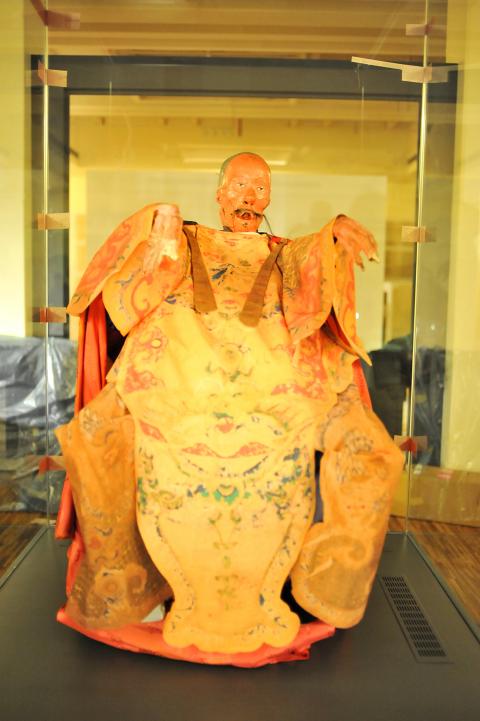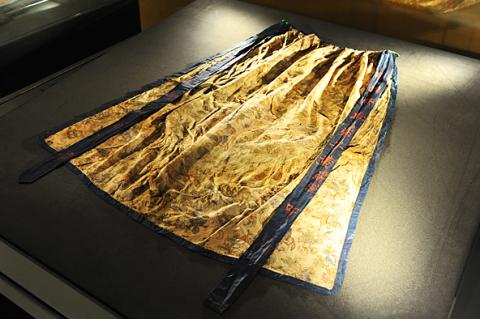For many in our secular society, death means the end. The curators at the National Taiwan Museum, however, believe that the idea of life can take on many forms and, in support of this thesis, has set up a controversial exhibition, Death is Just Another Beginning: Legend of the Taiwanese Mummy Ko Hsiang (死亡只是另一個開始:臺灣木乃伊「柯象」).
Born in 1845, Ko Hsiang (柯象), a shaman from what is today Yunlin County, is probably the only artificially mummified human corpse in Taiwan due to the popular belief at the time that mummification betrays the popular tradition that burying the dead assures their well being (入土為安). In Ko’s case, it is widely believed that he performed the procedure on himself so as to achieve immortality.
CORPSE LOCKED UP

Photo courtesy of National Taiwan Museum
Ko also serves as an important symbol of Taiwan’s anti-Japanese movement, said Li Tzu-ning (李子寧), an associate curator at the museum.
In 1912, almost two decades after Taiwan was ceded to Japan, Huang Chao (黃朝) attempted to rebel against the Japanese authorities in what has become known as the Tuku Incident (土庫事件). Huang planned the uprising in the name of Ko Hsiang, who had become a popular object of worship among religious believers.
“Following the revolt’s failure, police confiscated Ko Hsiang’s [corpse] as criminal evidence. But since no one knew what to do with it, the mummy was kept in police lockup for over 80 years,” Li told the Taipei Times.

Photo courtesy of National Taiwan Museum
Kasaburo Mitsuoka, a judge who paid special attention to the case, wrote in a legal journal that the trial and the use of the mummy as evidence was “an unheard-of bizarre event.”
NOT FOR THE KIDS
In the early 1990s, Ko was put on display at the National Taiwan Museum, stirring up unexpected fear and outrage. The exhibition was forced to close in 1997 due to overwhelming complaints from concerned parents.

Photo courtesy of National Taiwan Museum
“This time, we are not only exhibiting the object itself, we want to tell the story in the backdrop and highlight Ko Hsiang’s significance,” Li said.
In cooperation with National Taiwan Normal University, China Medical University Hospital and Beiji Temple, where Ko resided nearly a century ago, the museum has gathered his wardrobe, forensic records and comments from academics.
“From a scholar’s perspective, I think [the mummy] is extraordinary, mysterious and full of historical resonance. It’s an object that triggers in-depth thinking,” said Fan Yen-chiou (范燕秋), head of National Taiwan Normal University’s Graduate Institute of Taiwan History.
The mummy was a channel through which Taiwanese voiced their discontent with the Japanese government in the early colonial period, she said, interpreting the historic aspect of the sanctified body.
“Everyone sees Ko Hsiang in a different light and we encourage diversity from our audiences,” said Li, pointing to the mummy which has been “very much alive” for 135 years.

April 14 to April 20 In March 1947, Sising Katadrepan urged the government to drop the “high mountain people” (高山族) designation for Indigenous Taiwanese and refer to them as “Taiwan people” (台灣族). He considered the term derogatory, arguing that it made them sound like animals. The Taiwan Provincial Government agreed to stop using the term, stating that Indigenous Taiwanese suffered all sorts of discrimination and oppression under the Japanese and were forced to live in the mountains as outsiders to society. Now, under the new regime, they would be seen as equals, thus they should be henceforth

Last week, the the National Immigration Agency (NIA) told the legislature that more than 10,000 naturalized Taiwanese citizens from the People’s Republic of China (PRC) risked having their citizenship revoked if they failed to provide proof that they had renounced their Chinese household registration within the next three months. Renunciation is required under the Act Governing Relations Between the People of the Taiwan Area and the Mainland Area (臺灣地區與大陸地區人民關係條例), as amended in 2004, though it was only a legal requirement after 2000. Prior to that, it had been only an administrative requirement since the Nationality Act (國籍法) was established in

With over 80 works on display, this is Louise Bourgeois’ first solo show in Taiwan. Visitors are invited to traverse her world of love and hate, vengeance and acceptance, trauma and reconciliation. Dominating the entrance, the nine-foot-tall Crouching Spider (2003) greets visitors. The creature looms behind the glass facade, symbolic protector and gatekeeper to the intimate journey ahead. Bourgeois, best known for her giant spider sculptures, is one of the most influential artist of the twentieth century. Blending vulnerability and defiance through themes of sexuality, trauma and identity, her work reshaped the landscape of contemporary art with fearless honesty. “People are influenced by

Three big changes have transformed the landscape of Taiwan’s local patronage factions: Increasing Democratic Progressive Party (DPP) involvement, rising new factions and the Chinese Nationalist Party’s (KMT) significantly weakened control. GREEN FACTIONS It is said that “south of the Zhuoshui River (濁水溪), there is no blue-green divide,” meaning that from Yunlin County south there is no difference between KMT and DPP politicians. This is not always true, but there is more than a grain of truth to it. Traditionally, DPP factions are viewed as national entities, with their primary function to secure plum positions in the party and government. This is not unusual